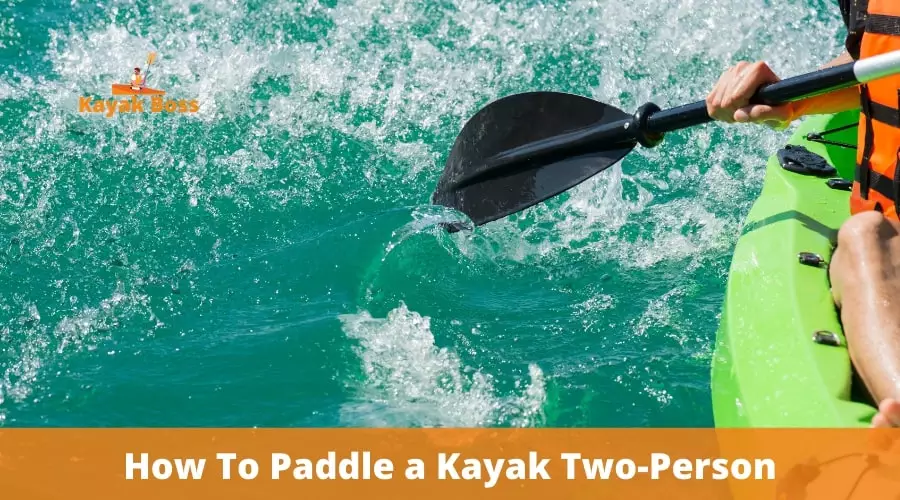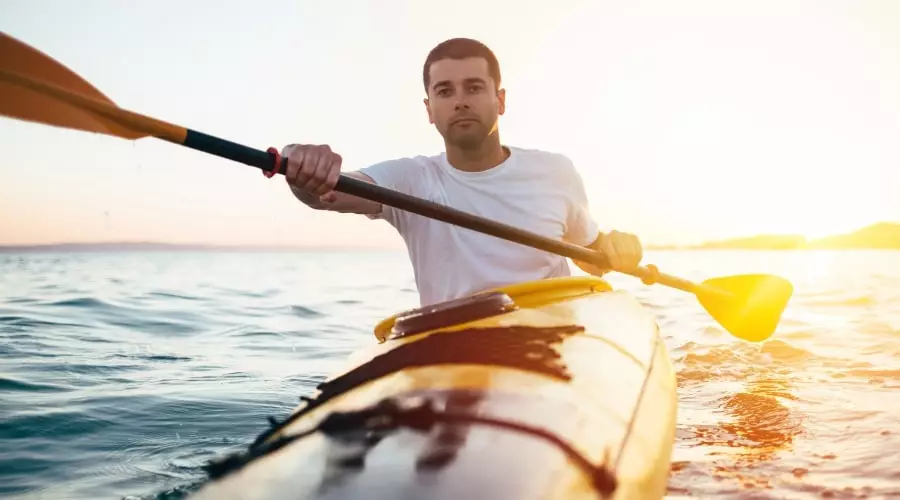Solo kayaks are an excellent form of marine sports gear for anyone who prefers to be out on the water rather than on land. For many, liberty on the water is the deciding factor in choosing kayaking as a sport.
Nonetheless, tandem kayaks, or kayaks for two people, are quite prevalent. A few of these models are frequently found among the most popular kayaks. You may share your kayaking adventure with anyone who is also enthusiastic if you know how to paddle a kayak two-person.

How do I paddle a two-person kayak?
Paddling a two-person kayak is a teamwork activity, and each person needs to work together to navigate the kayak in the desired direction. Here’s a step-by-step guide on how to paddle a two-person kayak:
- Choose your paddling positions: One person should sit in the front and the other in the back. The person in the back is responsible for steering the kayak and the person in the front is responsible for providing power and speed.
- Coordinate your strokes: Both paddlers should coordinate their strokes to ensure that they are paddling in a synchronized manner. This will help to prevent the kayak from turning in the wrong direction.
- Use opposite strokes: When one person paddles on one side, the other person should paddle on the opposite side to maintain balance and stability. This will also help to prevent the kayak from turning in the wrong direction.
- Communicate: Communication is key when paddling a two-person kayak. Both paddlers should communicate with each other and coordinate their strokes to ensure that the kayak is moving in the desired direction.
- Keep your body weight balanced: To maintain stability and prevent tipping, both paddlers should keep their body weight balanced and centered in the kayak.
- Take breaks as needed: Paddling can be strenuous, especially if you’re new to it. Don’t hesitate to take a break if you’re feeling tired.
By following these steps, you and your partner can have a successful and enjoyable paddling experience in a two-person kayak.
Choosing the Kayak
When it comes to two-person kayaks, the comparison between all-rounders and touring kayaks is frequently established. Sit-on-top kayaks and sit-in kayaks are frequently discussed. The type of structure is the first differentiation to make. All-round kayaks are shorter than touring kayaks. They provide less friction to the water as a result of their design, allowing them to attain greater speeds. Touring kayaks are ideally built for longer journeys.
When it comes to maneuverability and toppling stability, allrounders, on the other hand, are ahead. As a result, for novices, we propose all-around kayaks. Sit-in and sit-on-top kayaks are two types of kayaks. Distinctions in respect to the upper deck are used to categorize the items. Outdoor kayaks are sit-on-tops, whereas sit-in kayaks encircle the riders below the hips. The benefits and drawbacks of these structural variations are many. Even so, typically, two-person kayaks are sit-on-top kayaks, so it’s not a huge issue.
Guide to Paddle a Two-Person Kayak
Allow the paddler across from you to control the pace
The absence of synchrony among the paddlers is a typical concern in two-person kayaking. This causes the kayak to track unpredictably, causing uncertainty among the two riders. Allow the front paddler to control both the speed and the rhythm of the paddling to overcome this problem. To prevent disturbing the tracking, the back paddler should therefore follow.
Decide on which side the paddling will begin
Tandem kayaking might be unpleasant at first, but patience is something you should bring with you on your first excursion. It might be difficult to develop a rhythm, especially if you’re trailing along with a novice kayaker. Regularly interact, and you’ll quickly learn the basics in a fairly short period of time. If you implement a few instructions, you will have a better kayaking adventure.

Is it preferable to move toward the left or right? It’s a simple option, yet it may already be perplexing for two-person kayakers. Allow the front paddler to make the decision, and for a crisp beginning, count to three. As an example of how to paddle a tandem kayak, switch the movements on the sides. As a means of resolving the problem, avoid paddling on opposite sides.
Make use of the paddles that are appropriate for your degree of expertise
A paddle with a large blade would necessitate a more powerful grip and motion. The stronger kayaker should utilize this, while the other should employ a narrower paddle. Longer paddles are preferable if you’re both new to kayaking because they’re easier to swap while paddling. Shorter paddles require a higher level of accuracy, which may be readily attained with consistent practice. You can move to shorter and wider oars after the two of you have become acclimated to the sport.
Make the weaker rider the paddler in front
So, why should the weak kayaker be in charge of setting the speed? This is to ensure that the slower rider does not have difficulty catching up in the back. Allowing the rider to lead the paddling would simplify for the companion since he is more prepared to adjust to various paddling intensities. That is, in essence, how to ride a two-person kayak.
Allow the kayak’s front kayaker to board first
Allow the front paddler to ride in the kayak first while launching it. This is due to the fact that you, as the back paddler, are more adept at navigating the kayak. The front paddler will almost certainly require assistance getting into the kayak, so be calm and be one of the last to embark.
Prevent hitting the front kayaker with a paddle
Tandem kayaks are often longer than solo kayaks to allow the two passengers adequate room to maneuver about and exchange paddling strokes. However, the rear paddler may still hit the front rider with the blade. This is a common scenario for newcomers, but it can be avoided with practice. Request that the front paddler begin slowly so that you can practice different grip tactics on your kayak. You can check the review of Best Beginner Kayak Paddles Under $100.
FAQ
What is the best position for two people in a kayak?
The best position for two people in a kayak is to sit facing each other with one person in the front and one in the back. This allows for better communication and balance as well as makes it easier to paddle.
The three most important pieces of information are:
# Two people should sit facing each other.
# One person should sit in the front and one in the back.
# This position allows for better communication and balance.
What are the proper paddling techniques for two people in a kayak?
When paddling a two-person kayak, it is important to coordinate your movements with your partner. Each person should paddle on opposite sides of the kayak to maintain balance and to make it easier to navigate through the water.
The three most important pieces of information are:
# Coordinate movements with your partner.
# Paddle on opposite sides of the kayak.
# This helps maintain balance and makes it easier to navigate.
How should the weight distribution be in a two-person kayak?
In a two-person kayak, it is important to distribute the weight evenly between the front and back. This helps to maintain balance and stability in the kayak. If one person is significantly heavier than the other, it may be necessary to adjust the position of the heavier person to balance the weight distribution.
The three most important pieces of information are:
# Distribute the weight evenly between front and back.
# This helps maintain balance and stability.
# Adjust the position of the heavier person if necessary for weight distribution.
What should be considered when paddling in different water conditions?
When paddling in different water conditions, it is important to take into consideration the current, wind, and waves. These factors can affect the stability of the kayak and your ability to control it. In choppy or windy conditions, it may be necessary to adjust your paddling technique or position to maintain control and safety.
The three most important pieces of information are:
# Take into consideration the current, wind, and waves.
# These factors can affect stability and control.
# Adjust technique or position in choppy or windy conditions for control and safety.
How to Properly Use a Kayak Paddle
Conclusion
Your group kayaking adventures will be more enjoyable if you know how to paddle a kayak two-person. Gliding across the water with little effort requires only a few strides and continued practice.
